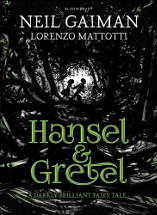Hansel and Gretel by Neil Gaiman

Ill. by Lorenzo Mattotti. Bloomsbury, 2014. ISBN 9781408861981
(Age: 10+) Highly recommended. Fairy tale, Witchcraft, Graphic
novel. With brooding black and white illustrations covering every
second double page, the familiar text between is permeated with
ominous dread as the children are duped into going into the forest
with their parents. There they are left, the first time finding
their way back home using small white stones dropped to show them
the way, and the second time using breadcrumbs which when eaten by
the birds, leaves them stranded. They discover a gingerbread house
in which lives an old woman who cages Hansel to fatten him up to
eat, forcing Gretel to cook and clean the house for her. But she
eventually outwits the old woman, killing her, releasing Hansel and
so finding their their way back home.
Gaiman has added to the original story, ensuring that modern readers
will equate the situation of the woodcutter and his family to the
plight of many children living with war in our world. Famine forces
the family to make this appalling decision, and today's readers will
have seen instances on television news of families deciding to send
their children to another country in the hope of keeping them alive
or children sold into slavery to save the remainder of the family.
The illustrations are outstanding, shadowing the story with an
overwhelming feeling of disquiet. The black threatening forest wraps
the pages, highlighting the small figures of Hansel and Gretel,
easily overshadowed by its ominous presence.
This is a book to read and reread, to ponder and discuss. It will
send readers back to the original story and its many rewritings, and
encourage readers to discuss the different versions available. An article
on Wikipedia will help here, and it is worth the while to check
library shelves to find other versions which can be read aloud and
shared with the class.
And Gaiman includes an outline of the history of the story and its
retellings at the end of the tale which adds another level of
interest and information. In reading this with a class, it maybe
helpful to encourage children to share what they know of the story
before this version is read, so there is some common understandings
of what the story is about, and when it was originally written, and
readers will clearly see the additions and changes made by
successive authors. This book is an absolute treat.
Fran Knight